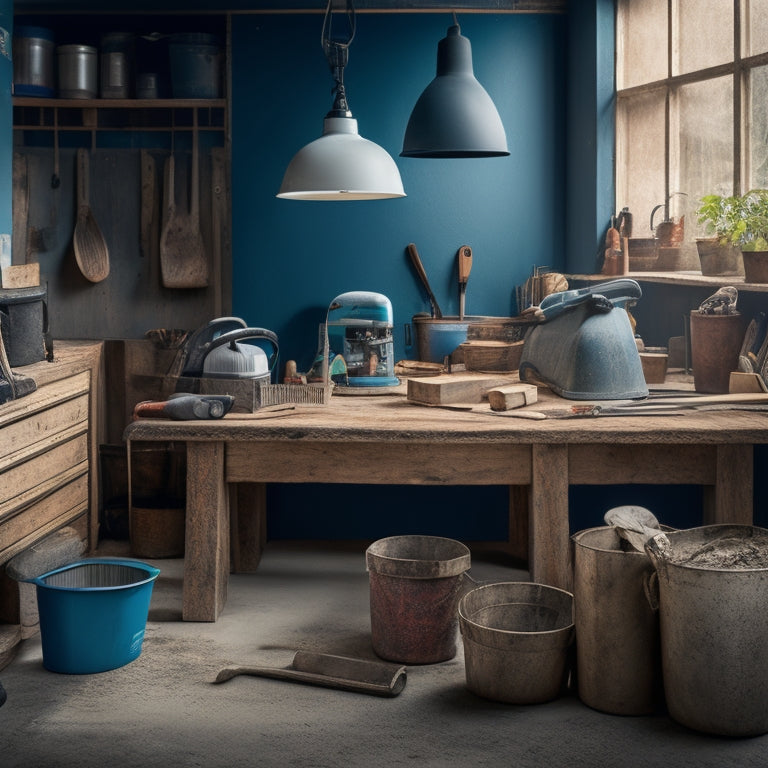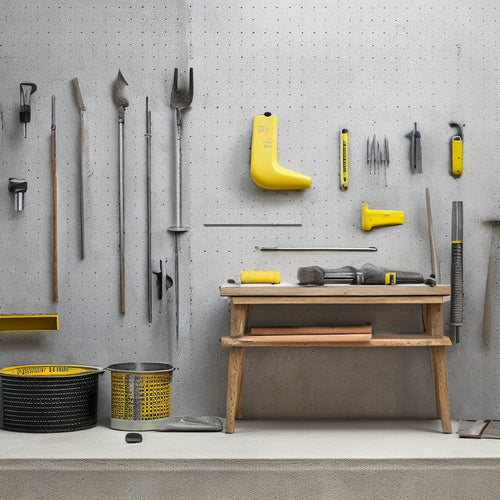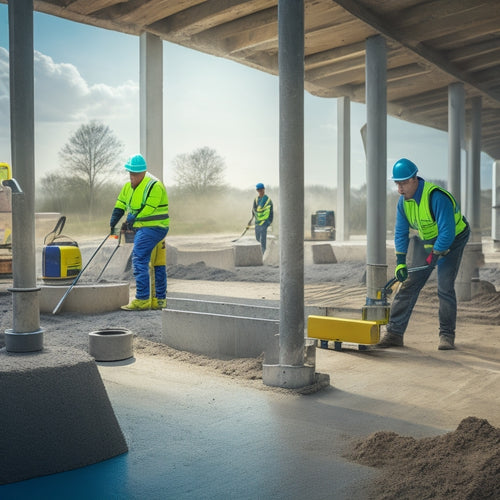
7 Must-Have Concrete Mixing Tools for DIY Rentals
Share
When tackling a DIY concrete project, you'll need the right mixing tools to guarantee a strong, consistent mix. A sturdy mixing bucket with a rust-resistant interior surface and a minimum 5-gallon capacity is crucial. A reliable mixing paddle with unique blade geometry and an ergonomic handle is also a must-have. Add a durable trowel, finishing tool set, and essential safety gear like hard hats and protective eyewear to your list. Don't forget efficient mixing paddles, quality concrete rake alternatives, and perfect edging tool solutions. With these 7 must-have tools, you'll be well on your way to a successful project - and discovering the nuances of each tool will elevate your results.
Key Takeaways
• Mixing buckets with a minimum capacity of 5 gallons and durable materials like polypropylene or steel are essential for DIY concrete mixing.
• A sturdy mixing paddle with a unique blade geometry and ergonomic handle is necessary for scraping the sides and bottom of the mixing drum efficiently.
• Durable trowels made of steel, aluminum, or fiberglass are required for finishing and smoothing out the concrete surface.
• A finishing tool set including edgers, jointers, and floats is necessary for achieving a professional-grade finish and smooth transitions between slabs.
• Hard hats and protective eyewear are vital safety gear to shield against debris and chemicals during the concrete mixing and finishing process.
Essential Mixing Bucket Requirements
Your mixing bucket must meet certain essential requirements to guarantee efficient concrete mixing, including a sturdy design, a capacity of at least 5 gallons, and a smooth, rust-resistant interior surface.
When it comes to mixing bucket materials, you'll want to opt for durable, heavy-duty options like polypropylene or steel. These materials can withstand the rigors of frequent use and harsh concrete ingredients. Avoid buckets made from flimsy materials like thin plastic or aluminum, as they'll likely crack or bend under the weight of the concrete.
Bucket size considerations are also vital. A minimum capacity of 5 gallons assures you can mix a sufficient amount of concrete for most small to medium-sized projects. However, if you're working on a larger project, you may need a larger bucket to accommodate more concrete.
Be mindful of the bucket's dimensions, too, as a larger bucket may be unwieldy or difficult to handle. By choosing a mixing bucket that meets these essential requirements, you'll be well on your way to achieving professional-grade concrete results.
Reliable Concrete Trowel Options
Reliable Concrete Trowel Options
With a reliable mixing bucket in hand, you can now focus on selecting a concrete trowel that can effectively apply and smooth out the freshly mixed concrete. A good trowel is essential for achieving a smooth, even finish, and there are several factors to evaluate when making your selection.
When it comes to trowel materials, you'll typically choose between steel, aluminum, or fiberglass. Each material has its own strengths and weaknesses, which are summarized in the table below.
| Material | Characteristics |
|---|---|
| Steel | Durable, heavy-duty, ideal for large projects |
| Aluminum | Lightweight, corrosion-resistant, suitable for smaller projects |
| Fiberglass | Lightweight, flexible, ideal for curved or irregular surfaces |
In addition to material, trowel size is also an important evaluation. Trowels come in a range of sizes, from 12 inches to 24 inches or more. Generally, larger trowels are better suited for larger projects, while smaller trowels are more maneuverable in tight spaces.
Must-Have Finishing Tool Sets
Once you've applied and smoothed out the concrete with your trowel, it's time to turn your attention to the finer details, and that's where a well-stocked finishing tool set comes into play. A thorough set should include edgers, jointers, and floats, each designed to refine specific aspects of your concrete surface.
Edgers help create clean, defined edges, while jointers guarantee a smooth, seamless change between slabs. Floats, on the other hand, are used to apply the final finish, leaving a smooth, even surface.
When selecting a finishing tool set, consider the finishing techniques you'll be employing. Will you be using a broom finish, a stamped finish, or something else? Choose tools that cater to your specific needs.
Additionally, don't forget about tool maintenance. Regularly clean and store your tools to prevent rust and extend their lifespan. A well-maintained tool set won't only provide better results but also save you time and money in the long run.
Efficient Mixing Paddle Designs
Their unique blade geometry and reinforced handle design make efficient mixing paddle designs a game-changer in concrete mixing, allowing you to tackle large batches with ease and precision.
You'll notice that these paddles feature curved or angled blades that effectively scrape the sides and bottom of the mixing drum, ensuring a consistent mix. Additionally, the reinforced handle design reduces fatigue and provides a secure grip, even when dealing with thick or heavy mixes.
When it comes to paddle material variations, you'll find options ranging from durable stainless steel to lightweight yet robust fiberglass or nylon. Each material has its own advantages, so it's vital to choose the one that suits your specific needs. For instance, stainless steel paddles are ideal for heavy-duty use, while fiberglass or nylon paddles are better suited for lighter mixing tasks.
Ergonomic handle designs also play an important role in efficient mixing paddle designs. Look for handles with contoured grips and balanced weight distribution, which enable you to maintain a comfortable grip and generate maximum mixing power with minimal effort.
Vital Safety Gear Essentials
When you're working with concrete, you're exposing yourself to a range of hazards that can cause serious injury.
You're responsible for ensuring you've got the right gear to protect yourself, and that starts with a hard hat that meets industry standards for impact resistance and a snug, secure fit.
You'll also need protective eyewear that provides a seal around your eyes and has lenses that can withstand flying debris.
Hard Hat Protection Essentials
You must wear a hard hat that meets the ANSI Z89.1 standard to protect your head from falling objects, electrical hazards, and other impacts on the construction site.
There are several hard hat types to choose from, including Type I, which protects the top of the head, and Type II, which provides additional protection to the sides and back of the head. When selecting a hard hat, consider factors such as the level of impact resistance, electrical resistance, and visibility required for your specific task.
Proper hard hat maintenance is also essential to guarantee its effectiveness. You should inspect your hard hat regularly for signs of wear, damage, or deterioration. Check for cracks, dents, or fading, and replace the hard hat if you notice any of these signs.
Additionally, clean your hard hat regularly with mild soap and water to prevent the buildup of dirt and debris. By choosing the right hard hat and maintaining it properly, you can greatly reduce the risk of head injuries on the construction site.
Protective Eyewear Requirements
In accordance with OSHA regulations, safety glasses or goggles must be worn on the construction site to shield your eyes from hazardous materials, flying debris, and chemical splashes.
When selecting protective eyewear, you should consider the specific hazards you'll face while mixing concrete. For instance, if you'll be working with chemicals, you'll need eyewear with a higher level of protection, such as chemical-resistant goggles.
Different eyewear types cater to specific safety standards. For example, ANSI Z87.1-compliant safety glasses provide impact protection, while goggles with a D3 rating offer protection against dust and debris.
You may also opt for prescription safety glasses or goggles with anti-fog coatings to guarantee clear visibility.
Quality Concrete Rake Alternatives
You're likely familiar with the importance of a concrete rake in achieving a smooth, even surface. However, concrete finishing experts often rely on a trusty concrete rake to achieve a smooth, even surface, but alternatives like tamping tools and bull floats can provide similar results with added benefits.
When considering alternatives to traditional concrete rakes, you should explore options that offer improved ergonomics and durability. Look for tamping tools and bull floats made from high-quality materials, such as heavy-duty steel or fiberglass, which can withstand the rigors of frequent use.
Ergonomic rake designs, featuring comfortable grips and balanced weight distribution, can reduce fatigue and improve control. These alternatives can also provide more precise control over the finishing process, allowing you to achieve a higher-quality finish with less effort.
Perfect Edging Tool Solutions
Achieving crisp, clean edges is a critical step in concrete finishing, and the right edging tool can make all the difference in delivering a professional-grade result. When it comes to perfect edging tool solutions, you'll want to invest in a high-quality edger that can help you achieve precise, decorative edges. Look for an edger with adjustable handles and a durable, rust-resistant blade that can withstand heavy use.
For more intricate edging techniques, consider an edger with interchangeable blades, allowing you to switch between different edge profiles with ease. Additionally, an edger with a built-in level will guarantee your edges are perfectly straight and level.
When working with concrete, it's crucial to have the right tools for the job. With an exceptional edger in your arsenal, you'll be able to create stunning decorative edges that elevate your concrete projects to the next level.
Frequently Asked Questions
Can I Use a Drill as a Substitute for a Mixing Paddle?
You can try using a drill with a mixing bit as a substitute, but it is crucial to choose the right drill type and mixing techniques to avoid uneven mixes and damage to the drill or bits.
How Often Should I Clean and Maintain My Concrete Tools?
You should clean your concrete tools after every use and perform deep cleaning weekly to maintain their longevity, as frequent cleaning prevents material buildup, ensuring peak performance and extending their lifespan.
Are Concrete Mixing Tools Suitable for Other Construction Tasks?
You'll find that concrete mixing tools are suitable for alternative construction applications beyond mixing concrete, thanks to the versatility of mixers, which can handle tasks like mixing mortar, grout, and even drywall compound with ease.
Can I Rent Concrete Mixing Tools for a One-Time Project?
"Ha! You think you'll only need concrete mixing tools once? Think again! But seriously, you can rent a concrete mixer for a one-time project, and it's a cost-effective solution, especially if you don't plan on using it frequently."
Do I Need a Specific Type of Concrete for DIY Projects?
When tackling a DIY concrete project, you'll need to choose a specific concrete type based on project considerations, such as temperature, humidity, and intended use, to guarantee the right strength, durability, and finish for your unique application.
Conclusion
Now that you've got the scoop on the 7 must-have concrete mixing tools for your DIY rental, it's time to get mixing!
With these essentials in your arsenal, you'll be the master of your own concrete domain.
Remember, a strong foundation is key, and with these tools, you'll be building on solid ground.
Don't let your project crumble - hammer out a successful DIY concrete project with these concrete mixing tools!
Related Posts
-

10 Must-Have Tools for Concrete Repair Organization
You'll need a solid organization system to keep your concrete repair tools and materials within easy reach, protected...
-

Essential Power Tools for DIY Concrete Sculpting
As you begin DIY concrete sculpting, you'll need a strategic selection of power tools to achieve professional-grade r...
-

What Tools Ensure Precise Concrete Leveling Results
You need a range of specialized tools to achieve precise concrete leveling results. Laser leveling instruments provid...


